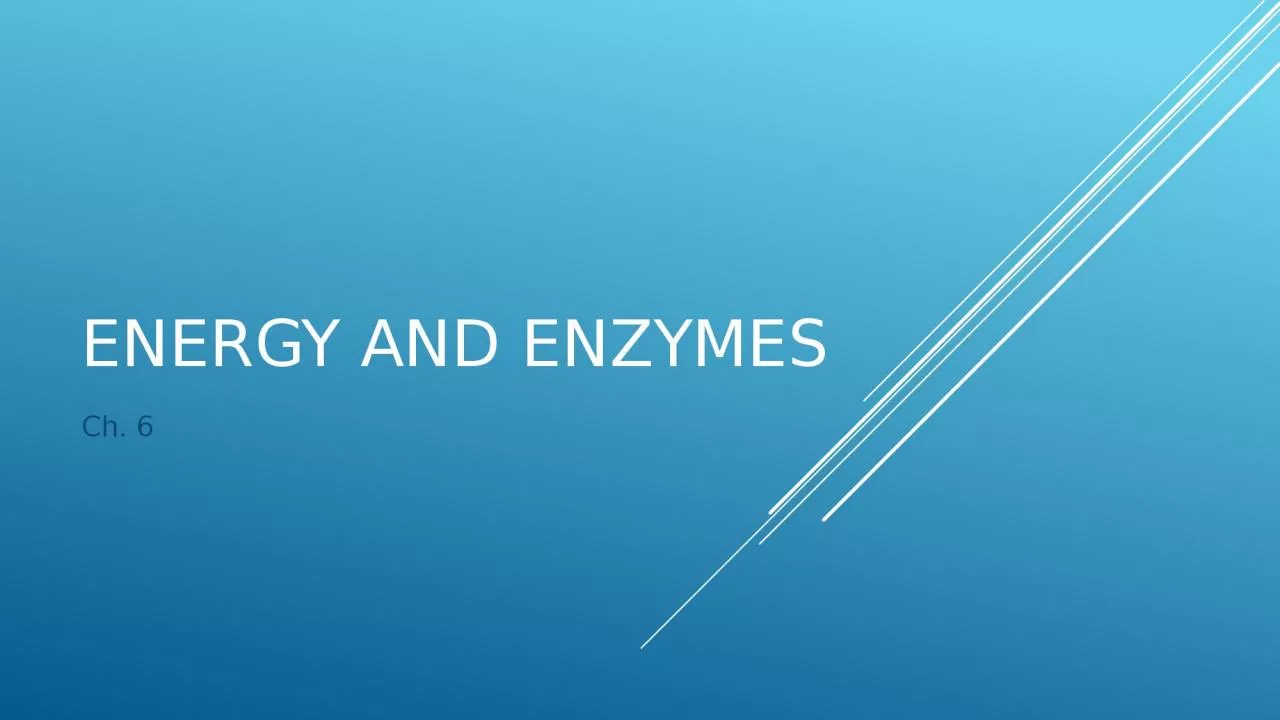

Flow of energy Energy is the ability to do work or bring a change There are 2 types of energy Kinetic Energy of motion Potential Stored energy Laws of Thermodynamics There is a constant flow of energy in biological systems ID: 1033203
Download Presentation The PPT/PDF document "Energy and Enzymes Ch. 6" is the property of its rightful owner. Permission is granted to download and print the materials on this web site for personal, non-commercial use only, and to display it on your personal computer provided you do not modify the materials and that you retain all copyright notices contained in the materials. By downloading content from our website, you accept the terms of this agreement.
1. Energy and EnzymesCh. 6
2. Flow of energy Energy is the ability to do work or bring a change. There are 2 types of energyKinetic- Energy of motionPotential- Stored energy
3. Laws of ThermodynamicsThere is a constant flow of energy in biological systems. The laws of thermodynamics explain why energy flows through ecosystems and cells. First Law of Thermodynamics- Law of conservation of energy (Energy cannot be created or destroyed, but it can change forms)Second Law of thermodynamics- Energy cannot change forms without a loss of usable energy.
4. Entropy (s) The second law of thermodynamics can be restated as energy transformation make the universe less organized. The term Entropy is used to indicate the relative amount of disorganization.
5. Metabolic reactions In cell biology, we use the concept of free energy instead of entropy. Free energy (ΔG) is the amount of energy left to do work after a chemical reaction has occurred. “available energy”. ΔG is determined by subtracting the free energy content of the reactants from that of the products. A –ΔG mean that the products have less free energy than the reactants. This is a endergonic reaction- meaning energy is required. A +ΔG is an exergonic reaction or spontaneous.
6. Gibbs Free Energy∆G= ∆H - T∆S∆H = Change in Enthalpy (Heat content) Measured in KJ/mol.T = Temperature in Kelvin∆S = Change in Entropy
7. ATPATP, or adenosine triphosphate, is the common energy currency of the cell. ATP is constantly being generated from ADP (adenosine diphosphate) and an inorganic phosphate molecule. ATP supplies come from the breakdown of glucose and other biomolecules. Only 39% of the free energy in glucose is converted to ATP.
8. APT StructureATP is a nucleotide of the base adenine and the 5-carbon sugar ribose (together called adenosine) and 3 phosphate groups. ATP is a “high energy” molecule because the phosphate groups are easy to remove.
9. The ATP cycle
10. Coupled reactionsATP hydrolysis is coupled to endergonic reactions so these reactions can have enough energy for the reaction to occur.
11. Example: Muscle Contractions
12. enzymesEnzymes are protein molecules that speed up a chemical reaction without being affected itself. The reactants of enzymatically accelerated reactions are called substrates. Ribozymes are RNA that also serve as biological catalyst.
13. EnzymesActivation EnergyReactants are generally reluctant to participate in a chemical reaction, unless energy is applied. This energy is called activation energy. Enzymes lower the activation energy. They do this by bringing substrates into contact with each other.
14. EnzymesInduced fit model The active site complexes with the substratesCauses active site to change shapeShape change forces substrates together or apart… initiating or breaking bonds
15.
16. enzymesFactors affecting Enzyme ActivitySubstrate concentrationEnzyme activity increases with substrate concentrationMore collisions between substrate molecules and the enzymeTemperatureEnzyme activity increases with temperatureWarmer temperatures cause more effective collisions between enzyme and substrateHowever, hot temperatures destroy enzymepHMost enzymes are optimized for a particular pH
17. Denaturation
18. enzymesFactors affecting Enzyme ActivityCells can affect presence/absence of enzymeCells can affect concentration of enzymeCells can activate or deactivate enzymeEnzyme Cofactors - Non-protein molecules that assist enzymes. (often metal ions, Fe2+)Coenzymes are organic cofactors, like some vitaminsPhosphorylation – some require addition of a phosphate
19. EnzymesEnzyme Cofactors (or Coenzymes)Some enzymes need cofactors to work; these are non-protein groups that attach to the enzyme. Ex. Minerals such as zinc or MgMany vitamins (because they are organic are important because they are called coenzymes
20. EnzymesReversible enzyme inhibitionWhen a substance known as an inhibitor binds to an enzyme and decreases its activityCompetitive inhibition – substrate and the inhibitor are both able to bind to active siteNoncompetitive inhibition – the inhibitor binds not at the active site, but at the allosteric siteFeedback inhibition – The end product of a pathway inhibits the pathway’s first enzyme
21. EnzymesAllosteric Enzymes- 2 binding sitesActive Site – substrate binds toAllosteric Site – allosteric affecter bindsAllosteric Activator – molecule binds to allosteric site and ACTIVATES enzyme.Creates active form of enzyme.Allosteric Inhibitor - molecule binds to allosteric site and INHIBITS enzyme.Creates inactive form of enzyme.
22.
23. Metabolic pathwaysMetabolic pathways are a series of linked chemical reactions.There can be many steps in metabolic pathway, in which each step requires a different enzyme to catalyze the reaction. The product of one reaction becomes the reactant of the next reaction. E1 E2 E3 E4 E5 A B C D E F
24. Enzyme InhibitorsInhibition is when the wrong molecule (an inhibitor) binds, blocking the active site; substrate can’t bindMany poisons are inhibitors of essential enzymes (e.g. death cap mushroom, arsenic, cadmium)
25. EnzymesMaterials that irreversibly inhibit an enzyme are known as poisonsCyanides inhibit enzymes resulting in all ATP productionPenicillin inhibits an enzyme unique to certain bacteriaHeavy metals irreversibly bind with many enzymesNerve gas irreversibly inhibits enzymes required by nervous system
26. http://www.bozemanscience.com/048-enyzmes